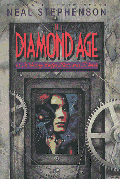
Neal Stephenson’s Snow Crash was one of the best science fiction books written in the 1990s–satiric, witty, thought-provoking, fun, and full of action. Had its ending lived up to the promise of the other 400 pages of the novel, and had Stan Robinson waited a while longer before writing his Mars epic, it is quite possible that Stephenson would have garnered a pair of awards for it.
As it was, a lot of people had a hard time believing that Snow Crash was Stephenson’s first novel–of course, that’s because it wasn’t. But not many science fiction readers (this one included) had read his farcical view of campus life, The Big U, or his ecological thriller, Zodiac. Stephenson’s name was new to the fans and he was literally the new kid on the block who everyone had to know and talk about. Most of the discussion ended with the question, “What next?”
What next was actually Interface, a near-future political thriller written in collaboration with his uncle and published under the pseudonym of Stephen Bury. This was not what fans wre expecting from Stephenson after the pyrotechnic Snow Crash, and it was probably a wise move for his publisher to print it under another name. For all their love of imagination and innovation, science fiction fans can rarely take too much of it from one author (which may end up being unfortunate for Stephenson, who is showing some amazing chameleon-like properties).
The Diamond Age is, however, the true child of Snow Crash, both the logical “second novel” for this “new” science fiction author, and the book that contains the freshness of the first with the wisdom of experience gained in the intervening time. While not as satiric as Snow Crash, this new novel more than makes up for it in the structured intensity of its plot and the internal consistency of character and place.
The subtitle of the book is “A Young Lady’s Illustrated Primer,” after the integral plot and science fictional element–a truly inter- active teaching tool designed by an innovative nanotech engineer named John Percival Hackworth to help innoculate the granddaughter of Equity Lord Finkle-McGraw with the idea of “taking chances” that seems to have been lost in the traditional teaching methods. Hackworth, in his own act of rebellion, makes a copy for his own daughter, Fiona, then loses the copy which falls into the hands of a waif named Nell.
In some ways this is a traditional science fiction novel–set in a strange new world with problems similar to our own (education, the fragmentation of society, and an inadequate division of wealth), numerous complications, a couple of action sequences, and a resolution. Stephenson retains some of his native humor, seen in Hackworth’s name (i.e., in relation to his position as the Hacker of the novel), as well as in the fractured fairy tale told in the Primer. In this novel, he seems to have more of a feeling for character–I especially felt an affinity towards Hackworth–although he still has the flashy language and technology that so endeared Snow Crash to fans.
The ending is still a disappointment. Not having read any of Stephenson’s other work besides Snow Crash and this novel, I don’t know if this is indicative of his work, but it is unfortunate. Once again, the promise of 400 pages is unrealized in the last 40 as The Diamond Age just seems to lose steam and fade off into the sunset. Characters last seen a hundred pages before are left unmentioned, a climatic “rescue” is missing its denounment, and everything seems unfinished. It is as if an entire chapter is missing. It’s not even as if he was setting it up for a sequel, although such is always a possibility these days.
Even with the null ending, I enjoyed The Diamond Age more than any other science fiction book in recent memory, and I look forward to Neal Stephenson’s next with even more anticipation than I did for this one.
[Finished 25 March 1995]
